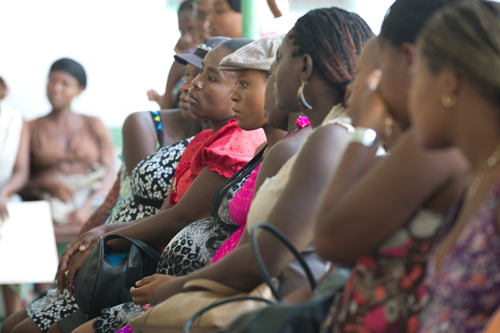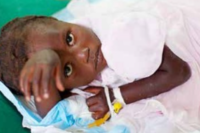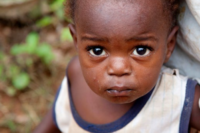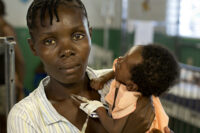Julienne is twenty-four. She lives in a small farming village with her common law spouse Bernard who works part time. They both have only completed some secondary schooling. (Schooling in Haiti is never a given; only half of Haiti’s children attend primary school. The few public schools that dotted the landscape several years ago received critical damage or outright destruction in the January, 2010 earthquake, when 4000 schools and several universities were destroyed.) Like most rural Haitians they live in a barter economy. Bernard’s job selling charcoal allows them to live together and to enjoy their Haitian small village life.
Julienne thinks that she missed her “monthly” sometime in late spring and might have been “late” shortly before hurricane season, which typically runs in Haiti from June to November. She came to HSC’s clinic for the first time after the New Year. Julienne was fortunate. She could afford to pay a few dollars to make the 10 km journey by overcrowded tap tap, unlike many women who must walk the distance.
Julienne told the physician she might have felt life, but because this would be a first pregnancy, she was unable to distinguish “baby movement” from normal stomach activity. HSC ran routine prenatal lab work and the results came back as WNL (within normal limits) for a beginning pregnancy, except for significant anemia. Julienne is Afro-Haitian so a sickle cell test was taken. When those results were negative, it was clear that her diet, largely rice with limited protein, was at fault. Like most rural Haitian pregnant women, she had iron deficient anemia.
There were no chartered pregnancy weights or blood pressures recorded prior to pregnancy that could help the OB-Gyn staff. Julienne measured bigger than her dates. A sonogram was ordered to try and pin point pregnancy dates. The sonogram revealed that Julienne was carrying twins and was probably 30 weeks pregnant. One baby’s head size was slightly smaller than the other, a medical condition called discordant growth or probable IUGR (Intrauterine Growth Retardation). Her blood pressure was moderately elevated at 135 / 85, she had back and stomach pains.
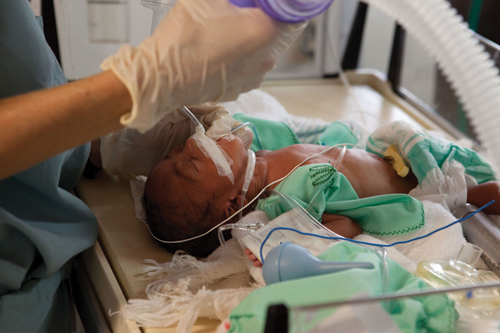 Twin pregnancy, anemia, late onset and limited pre-natal care coupled with blood pressure concerns, all add up to a “high risk pregnancy”. As a pregnant woman in rural Haiti, high risk pregnancy was regrettably the norm.
Twin pregnancy, anemia, late onset and limited pre-natal care coupled with blood pressure concerns, all add up to a “high risk pregnancy”. As a pregnant woman in rural Haiti, high risk pregnancy was regrettably the norm.
Only because of increasing abdominal pain, Julienne returned to the HSC clinic weeks later. She was about 32 weeks from her EDC (Estimated Date of Confinement). She had gained 16 pounds. Her ankles were swollen and the BP recorded 2 times had risen to 165-155/110-105 ranges. A check on Julienne’s urine with a “dipstick” showed Julienne was leaking proteins through her kidneys. Hospital care was mandated. Expecting improvement on home rest or that she would return was not reasonable.
Babies at 32 weeks are still too young. In past years, they died from premature lungs as did President John Kennedy’s son Patrick. Now, neonatologists know from experiments on baby animals lungs that small dosages of steroids given to the mother and passed through the placenta can hasten lung development if given 48 hours before birth. HSC with its 12 NICU isolettes and trained nurses can provide a safer haven for these fragile newborns than the expected probable rural home birth experienced by 50% of Haitian women.
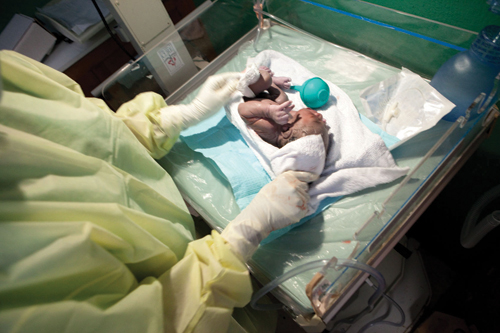 Julienne’s increasing abdominal pains were worrisome. After her admission to HSC as an inpatient, Julienne was carefully monitored. Her blood pressure rose despite medications given to keep it in a lower range (If the mother’s blood pressure is too, it deprives the babies of blood (IUGR); and, if the blood pressure is too high, it can cause the mother to stroke.) Simple in hospital measures were started like propping Julienne with pillows on her left side. By shifting the uterus off pressure on the right side blood vessels, oxygen and nutrition flow could reach the babies better through the placenta. Staff monitored urine amounts and
Julienne’s increasing abdominal pains were worrisome. After her admission to HSC as an inpatient, Julienne was carefully monitored. Her blood pressure rose despite medications given to keep it in a lower range (If the mother’s blood pressure is too, it deprives the babies of blood (IUGR); and, if the blood pressure is too high, it can cause the mother to stroke.) Simple in hospital measures were started like propping Julienne with pillows on her left side. By shifting the uterus off pressure on the right side blood vessels, oxygen and nutrition flow could reach the babies better through the placenta. Staff monitored urine amounts and
protein leakage.
The one sure cure for Toxemia of Pregnancy is delivery. Julienne’s blood pressure and urine showed deterioration over the next several days. There was a genuine fear her condition, severe pre-eclampsia was edging onward to actual eclampsia with convulsions. Decisions in these situations focus on the babies prematurity versus risk to a mother for her to continue to buy time for further “maturity” for the babies. The HSC staff recognized Julienne needed the surgical delivery and immediate “hand off” to the pediatric team.
A Cesarean section was performed and resulted in the delivery of a healthy girl and a healthy boy.
In 2012, Hôpital Sacré Coeur delivered 1,128 newborns. 259 or 23% of the deliveries were Cesarean Sections.
 Joseph Giere, M.D. is a Maryland based OB-Gyn and CRUDEM Board member who regularly volunteers at HSC.
Joseph Giere, M.D. is a Maryland based OB-Gyn and CRUDEM Board member who regularly volunteers at HSC.


